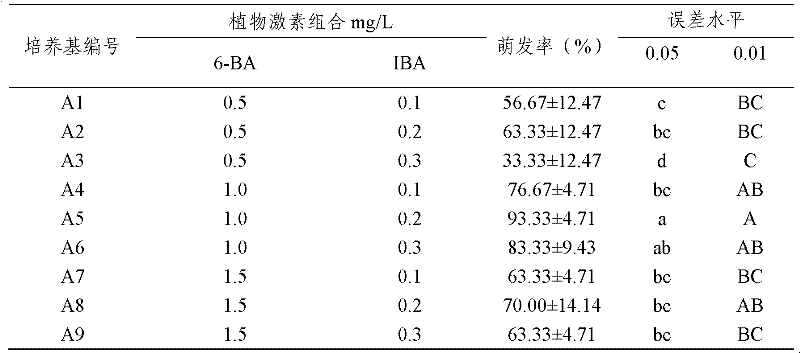Efficient induction method of plum blossom blade callus
A technology of callus induction and leaves, which is applied in the field of plant tissue culture, can solve the problems of high pollution rate and difficulty in callus induction, and achieve the effect of solving the source and realizing long-term preservation
- Summary
- Abstract
- Description
- Claims
- Application Information
AI Technical Summary
Problems solved by technology
Method used
Image
Examples
Embodiment 1
[0020] The collection and disinfection of embodiment 1 plum blossom explant
[0021] In spring, collect the fruits of the real plum variety 'Danhanhong' and wash them with clean water. Prepare a 1% potassium permanganate solution and place it in a 2L beaker, soak and clean the exocarp for 1 hour, rinse with running water for 1 hour until the water is clear. Lightly smash with a stone mortar, remove the pulp, lightly smash the endocarp, take the complete and plump seeds, soak in clean water to remove the seed coat, and cultivate the embryos for later use. Disinfect during inoculation, soak the seeds in 70% alcohol for 30s, soak in 1% mercuric chloride for 10min, rinse with sterile water 3 times, and inoculate for later use.
Embodiment 2
[0022] Embryo culture of embodiment 2 plum blossom seeds
[0023] Put the sterilized seeds of Example 1 on sterile filter paper, blot the water on the surface of the seeds; separate the cotyledon with tweezers, cut the lower half of the cotyledon with embryo with a blade, and remove one cotyledon and the other cotyledon 1 / 2 of the explants, and then inoculate the explants in 100ml Erlenmeyer flasks containing 40ml medium, and inoculate 3 explants in each bottle. The medium formula is MS+0.5-1.5mg / L 6-BA+0.1- 0.3mg / L IBA (see Table 1), which added 30g / L sucrose and 7g / L agar; put the culture bottle under dark conditions, culture at 25±3℃ for two weeks, and then switch to light culture , cultivated for two weeks. The light culture condition is light intensity 2000~3000Lx, light time 14h / d. Sterile vaccines can be obtained after inoculation for about one month. The results of hormone concentration and germination rate are shown in Table 1.
[0024] Table 1 Effects of differen...
Embodiment 3
[0027] Induction of embodiment 3 callus
[0028] When the aseptic seedling in embodiment 2 grows to 6-8 sheet leaves, get the 3-4th sheet blade that counts from top to bottom, cut 2-3 cuts along midrib 1 / 3, keep leaf edge to connect, Inoculate to MS + sucrose 30g / L + agar 7g / L + 2,4-D 0~3.0mg / L, pH=5.85 (see Table 2); place at a temperature of 25±3°C and culture in the dark for two weeks .
[0029] Table 2 Phytohormone induced callus
[0030]
[0031] It can be seen from Table 3 that the concentration of 2,4-D 0.25~3.0mg / L can induce callus tissue, but when the concentration of 2,4-D exceeds 1.00mg / L, callus tissue is more likely to occur Browning, necrosis and other phenomena, when the concentration of 2,4-D exceeds 2.50mg / L, the callus induction rate decreases. Considering comprehensively, when the concentration of 2,4-D is 0.5-1.50mg / L, the induction effect is better, and the optimal concentration is 1.0mg / L.
[0032] With the callus induction method established abov...
PUM
 Login to View More
Login to View More Abstract
Description
Claims
Application Information
 Login to View More
Login to View More - Generate Ideas
- Intellectual Property
- Life Sciences
- Materials
- Tech Scout
- Unparalleled Data Quality
- Higher Quality Content
- 60% Fewer Hallucinations
Browse by: Latest US Patents, China's latest patents, Technical Efficacy Thesaurus, Application Domain, Technology Topic, Popular Technical Reports.
© 2025 PatSnap. All rights reserved.Legal|Privacy policy|Modern Slavery Act Transparency Statement|Sitemap|About US| Contact US: help@patsnap.com



